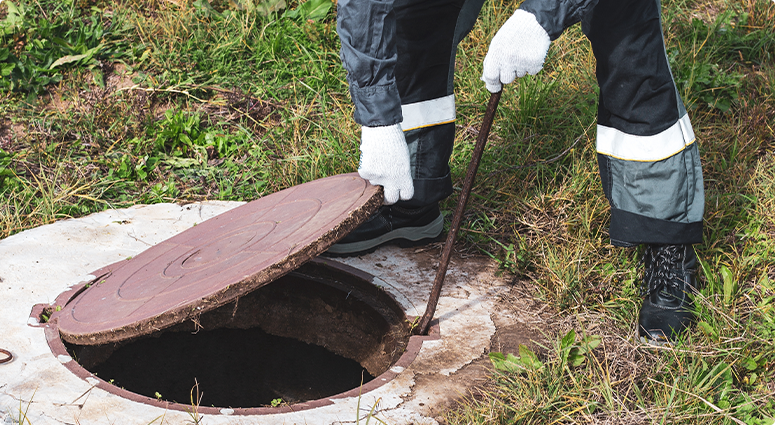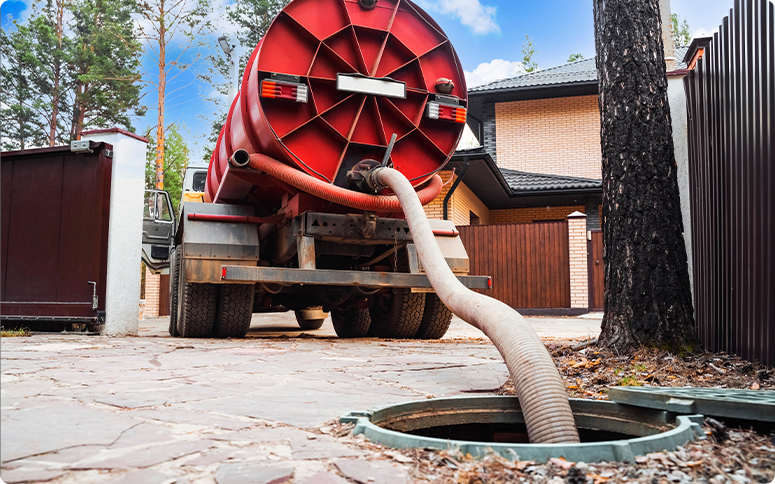Pressure distribution septic systems are advanced wastewater treatment solutions that evenly spread effluent throughout the entire drainfield using small-diameter pipes under low pressure. This technology pushes wastewater through holes drilled at specific intervals, creating a much more uniform distribution than traditional gravity systems.
They’re a key part of our wastewater treatment services at Clear Water Industries, designed to boost efficiency for Massachusetts residents with challenging site conditions or high-volume needs. If you want to know if this system makes sense for you, talk to our team. We’ve been installing and maintaining these systems throughout Massachusetts for decades.
Pressure distribution systems use a pump tank after your main septic tank to create consistent pressure that forces wastewater through small, strategically placed holes in pipes throughout your drain field. The main components include a septic tank for initial treatment, a pump chamber with float switches, a distribution network of small-diameter pipes (usually 1-2 inches), and a timer control panel.
The process starts when wastewater enters your septic tank for primary treatment. After the solids settle, the liquid flows to the pump chamber. When wastewater reaches a certain level, the pump activates, pushing effluent through the distribution pipes. This happens in controlled doses rather than continuous flow, giving the soil time to process each batch of wastewater. The timer can be set for specific cycles based on usage patterns.
This dosing approach replenishes oxygen in the soil between cycles, improving treatment efficiency and extending the system’s lifespan. The pressure created allows for even distribution across the entire drain field — a huge advantage over gravity systems, which often overload the areas closest to discharge points.
Gravity systems rely on – you guessed it – gravity to move wastewater through your drain field. Effluent flows downhill through large-diameter pipes (typically 4 inches) and exits through holes or pipe ends. The big drawback? Wastewater follows the path of least resistance, often saturating areas closest to the inlet while leaving distant sections of the drain field unused.
On the other hand, pressure distribution systems actively push wastewater through smaller pipes under pressure. This creates uniform distribution across your entire drain field, using every square foot of your disposal area. The efficiency boost makes a massive difference for Massachusetts properties with limited space or challenging soil conditions.
The contrast becomes most obvious in high-volume settings. Gravity systems in these environments often develop “biomat” clogging near inlet areas, leading to system failure and costly repairs. Pressure systems spread the load evenly, preventing any single area from becoming oversaturated.
Pressure systems also offer better treatment quality. By distributing effluent in thin layers throughout unsaturated soil, they maximize oxygen exposure and biological treatment, resulting in cleaner effluent and reduced environmental impact.
Pressure distribution systems really shine in specific scenarios that challenge conventional septic approaches. If your property has shallow soil depth to bedrock or groundwater, these systems can work effectively where gravity systems would fail. The controlled dosing and even distribution allow for proper treatment even with limited soil depth.
For homes and properties with high water usage or variable flow patterns, pressure distribution handles peak loads without flooding the drainfield. This adaptability helps maintain normal daily life without unexpected system failures.
Sites with problematic soil conditions – either too permeable (sandy soils) or not permeable enough (clay) – benefit from pressure distribution. In sandy soils, the pressurized delivery prevents wastewater from simply dropping straight down before proper treatment. With clay soils, the even distribution prevents pooling and maximizes available permeability.
These systems also prove valuable during seasonal shifts in Massachusetts. During heavy spring rains or winter freeze-thaw cycles, pressure distribution systems maintain effectiveness where gravity systems often struggle with saturation or freezing issues. This reliability keeps a household running without seasonal interruptions to wastewater management.
The design phase makes all the difference in pressure distribution system performance. Pipe diameter, hole sizing, spacing, pump selection, and drainfield configuration must all work together based on your specific site conditions and wastewater characteristics.
For typical Massachusetts properties, we assess flow patterns throughout your week. Many households have different wastewater outputs during mornings, evenings, and weekends. The pressure system’s timer controls can be programmed to handle these variations, with faster cycles during high-use periods and longer rest periods overnight.
Pipe networks need precise engineering. Holes that are too large allow excess flow near the pump; too small, and they risk clogging. We calculate the perfect balance based on your specific site conditions and expected usage. The drainfield layout itself also matters tremendously. Rather than the traditional long trenches of gravity systems, pressure distribution often works best with a bed configuration or multiple smaller zones that can be alternated.
Proper venting, freeze protection, and access points for maintenance must all be incorporated into the initial design. Getting these elements right from the start prevents costly retrofits and system failures down the road.



Clear Water Industries makes wastewater treatment and maintenance easier than ever. We provide a suite of services, including lift stations, recirculating sand filters, and the powerful Waterloo Biofilter® System. Call today!
The power of pressure distribution septic systems comes from their adaptability to the toughest site conditions while maintaining peak performance. As part of Clear Water Industries’ commitment to advanced wastewater treatment solutions for Massachusetts, we’ve refined these systems to handle everything thrown its way. Need a wastewater solution that won’t let you down? Speak with us today.